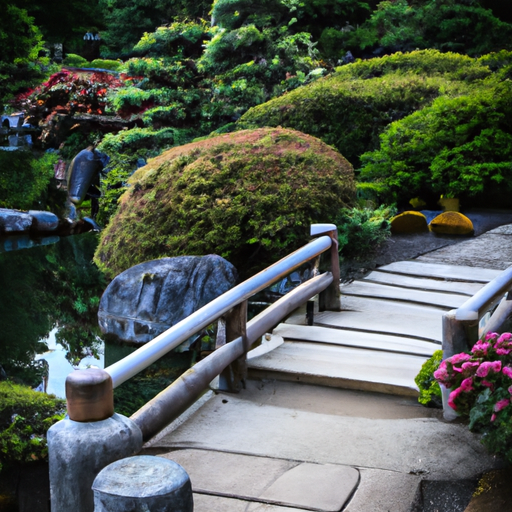In the enchanting world of Japanese gardens, various perspectives elevate your experience to another level. “Garden Glimpses: Viewing Platforms And Vantage Points In Japanese Designs” offers you a fascinating exploration of how specific viewpoints, like platforms and alcoves, enhance the tranquility and artistry of these tranquil havens. Prepare to be captivated as you discover the unique wisdom and foresight packed into the layout of renowned Japanese gardens, where every pebble, leaf, and water droplet plays a part in a larger, harmonious ensemble. Get ready, you’re about to immerse yourself in a Japanese garden like you’ve never seen it before – through the eyes of its designers.
Exploring the Concept of Viewing Platforms in Japanese Gardens
When you immerse yourself in the serene beauty of a Japanese garden, you are likely struck by the thoughtful design and delicate details. Each component within these visually enchanting spaces holds a purpose, and every element is designed specifically to maximize your experience. Among them, perhaps the most prominent are the viewing platforms, which are carefully designed and strategically placed to provide unique vantage points overlooking the landscapes.
Details of the Viewing Platform Concept
Your journey through a Japanese garden might lead you to one of these viewing platforms, where you can experience the garden from a special perspective and feel deeply connected to the surrounding natural beauty. These platforms can range from small, intimate spaces to grand and elaborate fixtures.
The Philosophical Implications of Viewing Platforms
You might find that viewing platforms hold profound philosophical implications, underpinned by the concept of ‘borrowed view’ prevalent in traditional Japanese aesthetics. They serve to extend the visual context beyond the physical garden boundaries, making it seem larger and more holistic.
Traditional Aspects of Japanese Garden Design
Even as you come across modern Japanese gardens, you’ll notice that they still retain significant aspects of tradition within their designs. These spaces, steeped in centuries of history, embody ancient philosophies, imparting wisdom through their intricate detailing and flow.
Japanese Garden Aesthetics
From the minimalist Zen gardens to the lushly landscaped stroll gardens, each type of Japanese garden is a testament to the artful balance between nature and man-made structures. Their aesthetics is meticulously designed, focusing on concepts like harmony, tranquility, and spiritual peace.
Historical Evolution of Japanese Gardens
Through hundreds of years, Japanese garden design has evolved, reflecting different eras and influences. From the first pond gardens of the Asuka period, inspired by Buddhist and Chinese influences, to the simple and elegant aesthetic of tea gardens mirroring the practises of the tea ceremony, each era has left its mark on the landscape of these gardens.
Role of Viewing Platforms and Vantage Points in Japanese Gardens
In the journey through the evolution of Japanese gardens, both viewing platforms and vantage points have played crucial roles. They serve as important visual elements but also spaces for contemplation and appreciation.
Importance of Contemplative Spaces
Viewing platforms, in particular, serve as peaceful, contemplative spaces where you can indulge in quiet reflection. The beautiful views open up more than just stunning landscapes; they open up opportunities to reflect deeply on life and the surrounding world.
The Use of Viewing Platforms for Garden Appreciation
Undoubtedly, viewing platforms are instrumental in promoting appreciation for the garden’s design and natural elements. They provide a stage for visitors to immerse themselves in the emotional and aesthetic experience of the garden, where the panoramic view enhances their appreciation for the harmony between natural elements and designed structures.
Types of Viewing Platforms in Japanese Gardens
As you explore Japanese gardens, you’re likely to encounter different types of viewing platforms, each contributing differently to your experience of the garden.
The Intimate Tea House Platforms
The intimate viewing platforms in tea houses are specially designed as private, tranquil spaces where you engage in mindfulness while enjoying a tea ceremony amidst a spectacular garden view.
The Grand Ornamental Pavilion Platforms
At the other end of the spectrum, the grand pavilion platforms offer captivating panoramic views that seem to encapsulate the entire garden and beyond, creating an expansive and immersive visual experience.
Architectural Styles and their Influence on Viewing Platforms
You’ll find that architectural styles greatly influence the design of viewing platforms and their role in Japanese gardens.
Influence of Japanese Architecture on Garden Design
Traditional Japanese architecture emphasizes harmony with nature. This principle is visibly carried into the design of viewing platforms, which blend seamlessly into the environment, providing serene spaces to appreciate the surrounding beauty.
Stylistic Features and their Impact on Viewing Platforms
Moreover, you’ll notice that distinct stylistic features of Japanese architecture, such as the use of natural materials and minimalistic design, heavily influence the construction of viewing platforms.
Vantage Points in Japanese Gardens
Vantage points, like viewing platforms, are integral parts of garden design, but with unique properties of their own.
Defining Vantage Points in Japanese Gardens
In Japanese gardens, vantage points are carefully considered spots from where the most beautiful garden views could be enjoyed. They could be spots on a stroll path, corners of a stepping-stone path or a position under a large tree.
Vantage Points and Perception of Space
Vantage points in a Japanese garden not only provide breathtaking views but also manipulate your perception of space. The designed perspectives can make the garden appear larger or smaller, enhancing the sense of mystery and exploration.
Visual Techniques for Maximizing Vantage Points
Japanese garden designers employ certain visual techniques to maximize the effect of these vantage points.
Use of Focal Points in Japanese Gardens
Strategic placement of focal points, such as distinct plants, rocks, or water bodies, serve to draw your attention, directing your gaze to the designed vantage point.
The Role of Distance and Perspective
The designers also play with distance and perspective. Longer views tend to create a sense of expansive space, while compact views bring an intimate feel. This manipulation of perspective intensifies your sensory experience.
Japanese Gardens and the Idea of Concealment and Revealment
A central theme recurring in Japanese gardens is the principle of concealment and revealment – showing and hiding elements to create interest and mystery.
Principle of Hide and Reveal in Japanese Aesthetics
This principle plays on the idea of ‘discovering’ a hidden garden. As you take a stroll, a seemingly concealed view suddenly reveals itself, adding an element of surprise and delight to your exploration.
How Concealment and Revealment are used in Garden Design
In terms of practical application, this principle often manifests in the way paths are designed, weaving in and out of the landscape, or how certain elements are partially hidden behind others, only revealed when you reach certain vantage points.
Case Studies of Famous Japanese Gardens
Two the most famous Japanese gardens, known for their iconic viewing platforms and vantage points, are The Katsura Imperial Villa and Ryoan-ji Zen Garden.
The Katsura Imperial Villa
Regarded as a masterpiece of Japanese aesthetics, The Katsura Imperial Villa integrates architecture and garden design seamlessly. Its tea houses feature intimate viewing platforms offering serene garden views.
Ryoan-ji Zen Garden
Ryoan-ji Zen Garden is renowned worldwide for its refined rock garden. Here, the viewing platform extends from the main hall, providing a perfect vantage point for contemplating the Zen artistry.
The Impact of Viewing Platforms and Vantage Points on Visitor Experience
As you have seen, viewing platforms and vantage points significantly influence the experience of visitors to a Japanese garden.
Enhancing Visitor Engagement
These spaces help in engaging you as a visitor more dynamically with the garden. You’re invited to interact with the garden visually, mentally, and emotionally.
Creating a Sense of Serenity and Tranquility
Perhaps more importantly, the views and perspectives from the platforms and the sense of discovery in reaching the vantage points add to the overall sense of tranquility – a feeling of calm and peace that’s at the heart of the Japanese garden experience.








